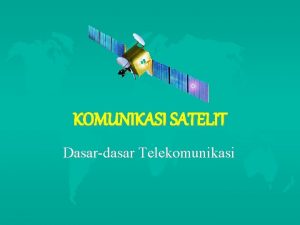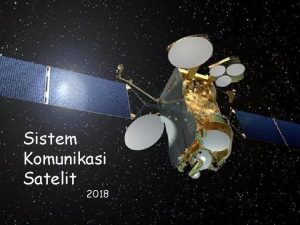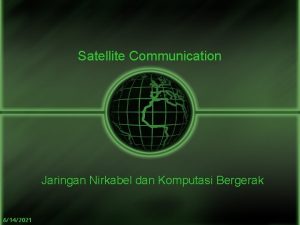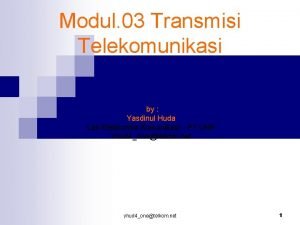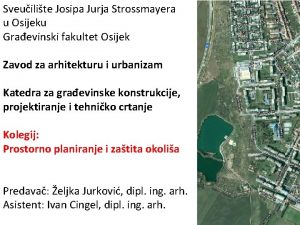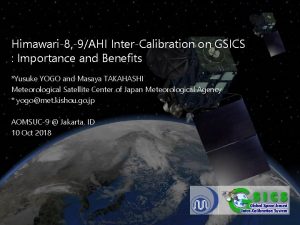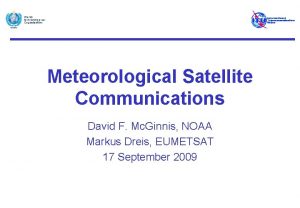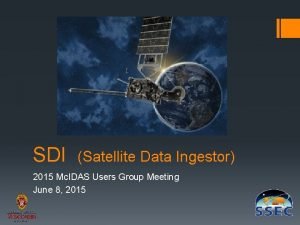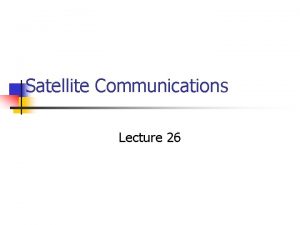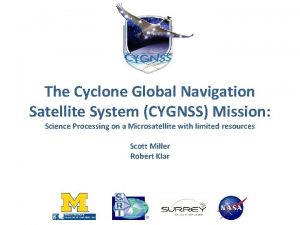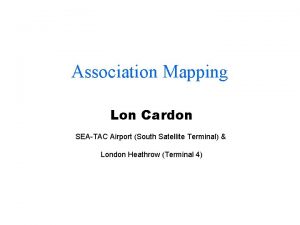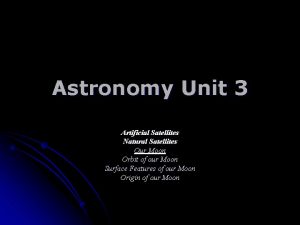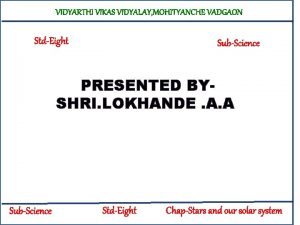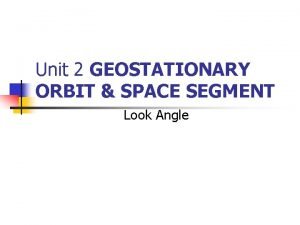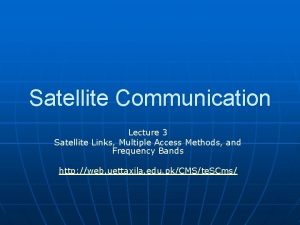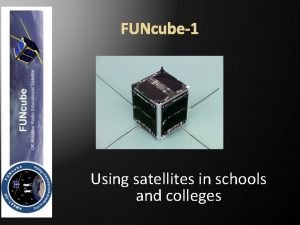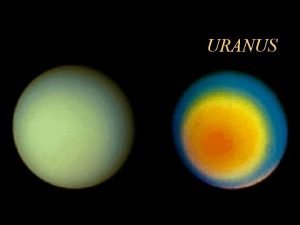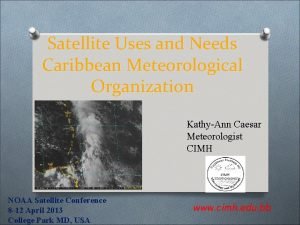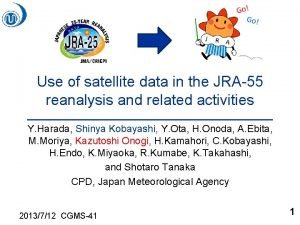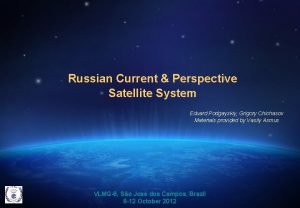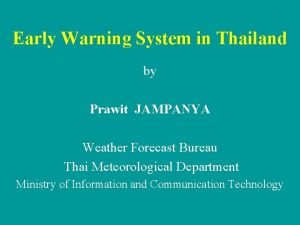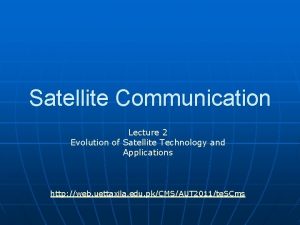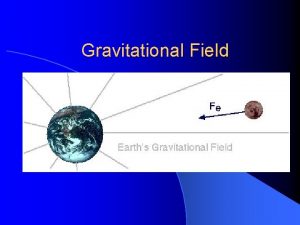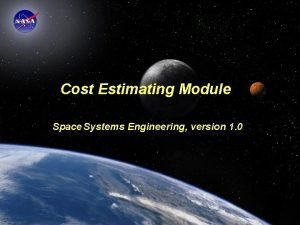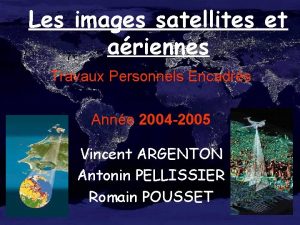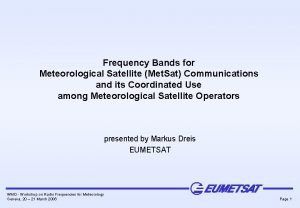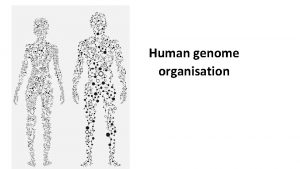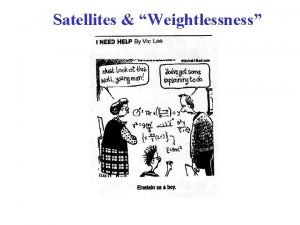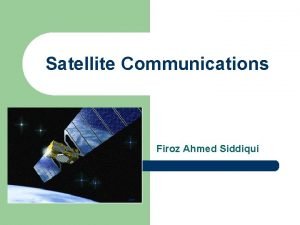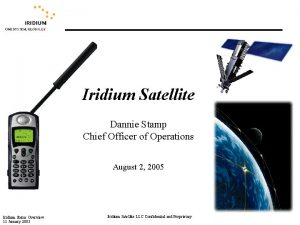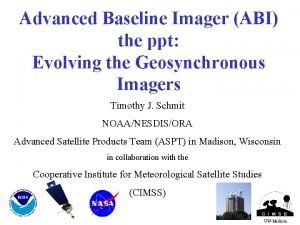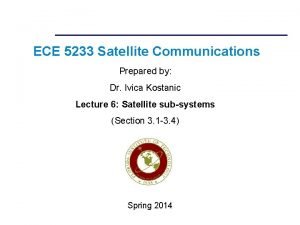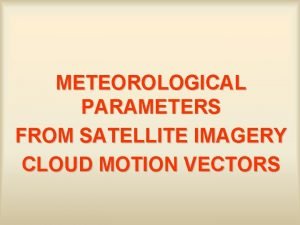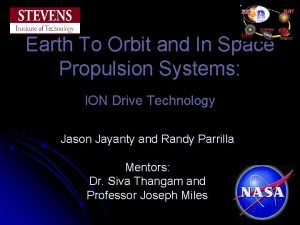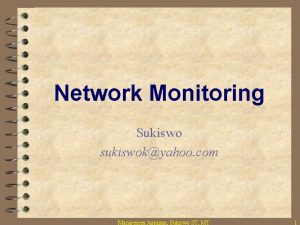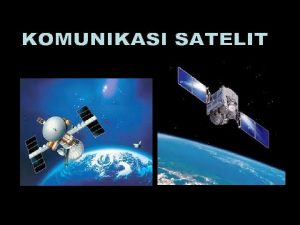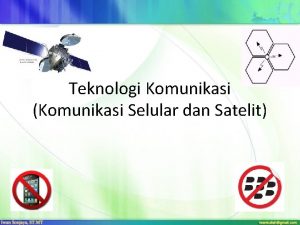Satellite Networking Sukiswo sukiswokyahoo com Komunikasi Satelit Sukiswo

































































- Slides: 65

Satellite Networking Sukiswo sukiswok@yahoo. com Komunikasi Satelit, Sukiswo, ST, MT 1

Outline 4 Network Refference Model 4 Architecture for Satellite Network 4 Basic Characteristic of Satellite Network 4 Satellite On-Board Connectivity 4 Connectivity Through Intersatellite Links Komunikasi Satelit, Sukiswo, ST, MT 2

OSI Refference Model Komunikasi Satelit, Sukiswo, ST, MT 3

TCP/IP Refference Model Komunikasi Satelit, Sukiswo, ST, MT 4

Architecture for Satellite Networks 4 Satellite networks are used to provide two major types of 4 4 service: TV services (associated with broadcast services) and telecommunication services (associated with two-way communication services, symmetric—telephony—or asymmetric—Internet access). One or more satellite networks can be deployed under the coverage of a single satellite and operated by a satellite network operator. It relies on a ground segment and utilises some satellite on-board resources (through the satellite channels that are used). The ground segment is composed of a user segment and a control and management segment. Komunikasi Satelit, Sukiswo, ST, MT 5

Architecture for Satellite Networks 4 In the user segment, one finds satellite terminals (ST) connected to the end-user customer premises equipment (CPE), directly or through a LAN and hub or gateway stations, sometimes called network access terminals (NAT), connected to terrestrial networks. – Satellite terminals are earth stations connected to CPE, sending carriers to or receiving carriers from a satellite. They constitute the satellite access points of a network; when the satellite network is a DVB-RCS network (designed according to the DVB-RCS standard), satellite terminals are also called Return Channel System Terminals (RCST). – CPE are also called user terminals (UT) and they include equipment such as telephone sets, television sets and personal computers. User terminals are independent of network technology and can be used for terrestrial as well as satellite networks. Komunikasi Satelit, Sukiswo, ST, MT 6

Architecture for Satellite Networks – CPE are also called user terminals (UT) and they include equipment such as telephone sets, television sets and personal computers. User terminals are independent of network technology and can be used for terrestrial as well as satellite networks. – The gateway earth station (GW) provides internetworking functions between the satellite network and the Internet or a terrestrial network. Komunikasi Satelit, Sukiswo, ST, MT 7

Architecture for Satellite Networks 4 The control and management segment consists of: – a mission and network management centre (MNMC) in charge of non-real-time, high-level management functions for all the satellite networks that are deployed in the coverage of a satellite. – network management centres (NMC), also called interactive network management centres (INMC), for non-real-time management functions related to a single satellite network. – network control centres (NCC) for real-time control of the connections and associated resources allocated to terminals that constitute one satellite network. 4 A satellite network (also called a satcom network) comprises a set of satellite terminals, one or more gateways and one NCC that is operated by one operator and uses a subset of the satellite resources (or capacity). Komunikasi Satelit, Sukiswo, ST, MT 8

Satellite Network Components NMC=network management NAT=centres network access terminals NCC =network control centres GW=gateway earth station MNMC =mission and network management centre ST =satellite terminals INMC =interactive network management centres CPE=customer premises equipment Komunikasi Satelit, Sukiswo, ST, MT 9

Characteristic of Satellite Network 4 Satellite networks are characterised by their topology (meshed, star or multi-star), the types of link they support and the connectivity they offer between the earth stations. Komunikasi Satelit, Sukiswo, ST, MT 10

Meshed Satellite Topology 4 A meshed satellite network consists of a set of earth stations which can communicate one with another by means of satellite links consisting of radio-frequency carriers. Komunikasi Satelit, Sukiswo, ST, MT 11

Meshed Satellite Topology 4 A meshed satellite network can rely on a transparent or a regenerative satellite. 4 In the case of a transparent satellite, the radio-frequency link quality between any two earth stations in the network must be high enough to provide the end users with a service achieving the target bit error rate. 4 This implies sufficient EIRP and G/T for each earth station, given the satellite transponder operating point. 4 In the case of a regenerative satellite, the on-board demodulation of the signal puts fewer constraints on the EIRP and G/T of the earth stations. Komunikasi Satelit, Sukiswo, ST, MT 12

Star Satellite Topology 4 In a star network, each node can communicate only with a single central node, often called the hub. 4 A star satellite network consists of earth stations which can communicate only with a central earth station called the hub. Komunikasi Satelit, Sukiswo, ST, MT 13

Star Satellite Topology 4 Hub is a large earth station (antenna size from a few meters to 4 4 more than 10 m) with higher EIRP and G/T than the other earth stations in the network. A star network topology places fewer constraints on the EIRP and G/T of the earth stations than a meshed network topology relying on a transparent satellite, due to the fact that the earth stations communicate with a large earth station (the hub). This architecture is popular among networks populated with small earth stations (antenna size of about 1 m) called very small aperture terminals (VSAT) [MAR-02]. The link from any earth station to the hub is called an inbound link or return link. The link from the hub to the other earth stations is called the outbound link or forward link. Komunikasi Satelit, Sukiswo, ST, MT 14

Types of link 4 Two types of link can be established through a satellite network: unidirectional links, where one or several stations only transmit and other earth stations only receive, and bidirectional links, where earth stations both transmit and receive. 4 Unidirectional links are usually associated with a star topology, in satellite broadcast-oriented networks. 4 Bidirectional links can be associated with a star or meshed topology and are required to transport any two-way telecommunication services. Komunikasi Satelit, Sukiswo, ST, MT 15

Types of Network Connectivity 4 Connectivity characterises the way nodes of a network are connected to each other. 4 When a communication link is established through a satellite network, two levels of connectivity need to be distinguished: the connectivity required at the service level and the connectivity required on board the satellite. 4 The connectivity at the service level defines the type of connection that is necessary between CPEs or network equipment, and between satellite terminals or gateways, to provide the service required by end users. 4 This connectivity is principally processed on the ground and relies on ‘identifiers’ associated with sessions, layer 3 and layer 2 connections. Komunikasi Satelit, Sukiswo, ST, MT 16

Types of Network Connectivity 4 Satellite on-board connectivity defines how the satellite network resources are switched on board in order to meet the service-level connectivity requirements. 4 It therefore depends on how the satellite resources (beams, channels, carriers, etc. ) are organised on both satellite upand downlinks and, primarily, on the type of coverage that the satellite system provides. Komunikasi Satelit, Sukiswo, ST, MT 17

Satellite On-Board Connectivity Komunikasi Satelit, Sukiswo, ST, MT 18

Satellite On-Board Connectivity 4 Satellite on-board connectivity can be provided at the following levels: – Spot-beam: The whole frequency resource allocated to a beam is switched on board; this can correspond to a channel or several channels (typically 125 or 250 MHz in Ka band). – Channel: This is equivalent to the frequency resource that is classically transmitted through a transponder (typically 36 or 72 MHz). – Carrier: This can be an FDMA carrier transmitted by a satellite terminal or earth station, or an MF-TDMA carrier that is shared by several satellite terminals (typically from a few k. Hz up to tens of MHz depending on the earth station radio capability). – Time slot: This corresponds to TDM or TDMA time slots. – Burst, packet or cell: This corresponds to any type of layer 2 packet, up to IP datagrams. Komunikasi Satelit, Sukiswo, ST, MT 19

Satellite On-Board Connectivity 4 Figures below correspond to different levels of granularity and they imply different types of processing Komunikasi Satelit, Sukiswo, ST, MT 20

Satellite On-Board Connectivity 4 Depending on the on-board processing capability and the network layer, different techniques are considered for interconnection of coverage: – transponder hopping (used when there is no on-board processing); – on-board switching (used when there is transparent and regenerative processing); – beam scanning. Komunikasi Satelit, Sukiswo, ST, MT 21

Connectivity With Transponder Hopping Komunikasi Satelit, Sukiswo, ST, MT 22

Connectivity With Transponder Hopping 4 Interkoneksi ini digunakan jika jumlah beam sedikit 4 Bandwidth total sistem dibagi menjadi beberapa sub-band sebanyak jumlah beam 4 Terdapat sejumlah filter secara onboard disatelit untuk memisahkan carrier yang berhubungan dengan jumlah sub-band yang digunakan 4 Output dari tiap filter terhubung ke antena beam tujuan melalui transponder 4 Jumlah filter dan transponder minimal sama dengan kuadrat dari jumlah beam Komunikasi Satelit, Sukiswo, ST, MT 23

Connectivity With Transponder Hopping 4 Stasiun bumi harus mampu mengirimkan/menerima dalam beberapa frekuensi dan beberapa polarisasi agar proses interkoneksi disatelit dapat melompat dari transponder satu ke transponder lainnya (transponder hopping) 4 Interkoneksi ini biasanya digunakan jika jumlah beam sedikit 4 Jika jumlah beam banyak maka penggunaan interkoneksi transponder hopping tidak lagi optimal karena jumlah transponder minimum sama dengan kuadrat dari jumlah beam→satelite mjd berat Komunikasi Satelit, Sukiswo, ST, MT 24

Connectivity On With Transparent Processing 4 Beam switching by transponder hopping is a solution when the number of beams is low. 4 Because the number of transponders increases at least as the square of the number of beams, with a large number of beams the satellite payload becomes too complex and too heavy. 4 It is therefore necessary to consider on-board switching at a lower granularity, and shift from beam switching to channel switching. Komunikasi Satelit, Sukiswo, ST, MT 25

Connectivity On With Transparent Processing 4 Two types of technology can provide this kind of connectivity: – analogue technology using an intermediate frequency-switching matrix, one example of which is known as satellite switched/TDMA (SS/TDMA), – digital technology using baseband processing equipment, in particular digital transparent processors (DTP). Komunikasi Satelit, Sukiswo, ST, MT 26

Connectivity On Board Switching (SS/TDMA) Komunikasi Satelit, Sukiswo, ST, MT 27

Connectivity On Board Switching (SS/TDMA) 4 Pada payload terdapat programable switch matrix yang 4 4 mempunyai jumlah input = jumlah output = jumlah beam Switch matrix ini menghubungkan tiap up beam ke down beam dan jumlah repeater sama dengan jumlah beam DCU (Distribution Control Unit) berfungsi untuk mengatur switch matrix pada proses pembangunan koneksi Jika koneksi antar 2 beam adalah cyclic (berulang) maka stasiun DCU akan menyimpan trafik dari banyak user dan mengirimkan trafik dalam bentuk burst jika interkoneksi antar beam telah selesai Jenis interkoneksi ini digunakan pada transmisi digital dan jenis multiple access TDMA →SS-TDMA (Satellite Switched Time Division Multiple Access) Komunikasi Satelit, Sukiswo, ST, MT 28

Frame Organisation on SS/TDMA 4 Tiap frame berisi field sinkronisasi dan field trafik 4 Contoh organisasi frame untuk 3 beam : 4 Window : durasi (lama) waktu koneksi dari satu up beam ke satu down beam Komunikasi Satelit, Sukiswo, ST, MT 29

Window Organisation on SS/TDMA 4 Pengaturan burst pada interval waktu satu window 4 Gambar disamping menunjukkan burst –burst yang akan ditransmisikan oleh stasiun A, B dan C pada window yang berhubungan dengan koneksi dari beam 3 ke beam 2 4 Masing–masingburst yang ditransmisikan oleh stasiun pada selang waktu window berisi beberapa sub burst yang berisi informasi stasiun ke stasiun Komunikasi Satelit, Sukiswo, ST, MT 30

Synchronisation On Processing SS TDMA 4 Ada 2 aspek sinkronisasi: – Sinkronisasi antar stasiun bumi – Sinkronisasi antara stasiun bumi dengan satelit 4 Sinkronisasi antar stasiun bumi: – Sinkronisasi antar stasiun bumi menggunakan single beam TDMA. Ada 2 teknik: • Sinkronisasi closed loop • Sinkronisasi open loop Komunikasi Satelit, Sukiswo, ST, MT 31

Synchronisation On Processing SS TDMA Komunikasi Satelit, Sukiswo, ST, MT 32

Close Loop Synchronisation Komunikasi Satelit, Sukiswo, ST, MT 33

Open Loop Synchronisation Komunikasi Satelit, Sukiswo, ST, MT 34

Open Loop Synchronisation Komunikasi Satelit, Sukiswo, ST, MT 35

Sinkronisasi Antara Stasiun Bumi Dengan Satelit Komunikasi Satelit, Sukiswo, ST, MT 36

Troughput Frame pada On Board Processing Komunikasi Satelit, Sukiswo, ST, MT 37

Digital transparent switching 4 Digital technology, relying on digital filtering and switching. 4 The principle of a digital transparent processor that enables the switching of uplink carriers from one spot beam to another spot beam and the transposition of frequency. Komunikasi Satelit, Sukiswo, ST, MT 38

Digital transparent switching Komunikasi Satelit, Sukiswo, ST, MT 39

Connectivity With Regenerative Processing 4 The availability on board the satellite of binary digits obtained after demodulation and decoding, offers several opportunities, and in particular allows the introduction of some layer 2 switching on board the satellite. Komunikasi Satelit, Sukiswo, ST, MT 40

On Board Processing 4 Proses yang terjadi secara on board disatelit: – Downlink Coding – Baseband switching – Rate Convertion – Beam Scanning – Proses FDMA/TDM Komunikasi Satelit, Sukiswo, ST, MT 41

Downlink Coding 4 Pada arah downlink encoder ditempatkan secara on board 4 4 disatellite dan diaktivasi oleh telecommand Akan menghasilkan decoding gain dan laju transmisi akan bertambah(sebanding dg 1/code rate) Sehingga pd arah downlink dibatasi oleh power bukan bandwidth Jika link dibatasi oleh bandwidth maka laju transmisi harus dimaintained sehingga laju informasi akan turun Akibat penggunaan encoder pd arah downlink adalah akan terdapat margin C/Noyang dapat digunakan untuk mengantisipasi redaman hujan Komunikasi Satelit, Sukiswo, ST, MT 42

Baseband Switching 4 Proses switching antara antena kirim dan antena terima dilakukan dilevel baseband setelah proses modulasi dan demodulasi 4 Dilakukan pada data rate yang rendah Komunikasi Satelit, Sukiswo, ST, MT 43

Baseband switching 4 The availability of bits on board the satellite at the output of the uplink carrier demodulators permits switching between receiving and transmitting antennas to be no longer at radio frequency but at baseband. 4 The constraint of immediate routing of received information to the destination downlink disappears. 4 This permits earth stations to transmit all their information in the same burst and hence to transmit only a single burst per frame. The number of bursts per frame is reduced and the efficiency of the frame increases. Komunikasi Satelit, Sukiswo, ST, MT 44

Baseband switching Komunikasi Satelit, Sukiswo, ST, MT 45

Rate Convertion 4 Satelit tipe transparent repeater : Terdapat link terestrial dan terjadi 2 hop Komunikasi Satelit, Sukiswo, ST, MT 46

Rate Convertion 4 Satelit tipe regenerative repeater : Komunikasi Satelit, Sukiswo, ST, MT 47

Beam Scanning Satelite 4 Single beam yg dihasilkan satelit akan melakukan scan terhadap area servis secara sekuensial 4 Keuntungan: Akan mengurangi Co-channel interference karena pengalokasian beam yang dinamik Komunikasi Satelit, Sukiswo, ST, MT 48

Beam Scanning Satelite 4 Contoh: NASA ATCS (Advance Technology Communication Sattelite) Satellite; Menggunakan 2 beam untuk scanning (uplink dan downlink) 4 Payload : Komunikasi Satelit, Sukiswo, ST, MT 49

FDMA/TDM 4 Satelit tipe regenerative mempunyai kelebihan: – Dapat mereduksi EIRP stasiun dan G/T stasiun bumi – Dapat mengimplementasikan FDMA pd arah uplink dan. TDM pd arah downlink Komunikasi Satelit, Sukiswo, ST, MT 50

Connectivity With Beam Scanning Komunikasi Satelit, Sukiswo, ST, MT 51

Connectivity With Beam Scanning Komunikasi Satelit, Sukiswo, ST, MT 52

Connectivity Through Intersatellite Links Komunikasi Satelit, Sukiswo, ST, MT 53

Connectivity Through Intersatellite Links 4 Intersatellite links (ISL) can be considered as particular beams of multibeam satellites; the beams in his case are directed not towards the earth but towards other satellites. 4 For bidirectional communication between satellites, two beams are necessary—one for transmission and one for reception. 4 Network connectivity implies the possibility of interconnecting beams dedicated to intersatellite links and other links at the payload level. Komunikasi Satelit, Sukiswo, ST, MT 54

Connectivity Through Intersatellite Links 4 Three classes of intersatellite link can be distinguished: – links between geostationary earth orbit (GEO) and low earth orbit (LEO) (inter-orbital links (IOL); – links between geostationary satellites (GEO– GEO); – links between low orbit satellites (LEO–LEO). Komunikasi Satelit, Sukiswo, ST, MT 55

Links between GEO–LEO 4 This type of link serves to establish a permanent relay via a geostationary satellite between one or more earth stations and a group of satellites proceeding in a low earth orbit at an altitude of the order of 500 to 1000 km. 4 One or more geostationary satellites are therefore used; they are permanently and simultaneously visible both from stations and low earth orbit satellites and serve to relay communications. 4 This technique also permits overcoming possible limitations of the terrestrial network. Komunikasi Satelit, Sukiswo, ST, MT 56

Links between GEO–LEO Example : 4 NASA tracking network by means of the tracking and data relay satellites (TDRS) which, in particular, provide communication with the International Space Station. 4 European programme has successfully launched a data relay payload (ARTEMIS satellite) to provide communications between the ground and low earth orbit spacecrafts. Komunikasi Satelit, Sukiswo, ST, MT 57

Increasing the capacity of a system Second satellite is launched to increase the capacity of the space segment—the stations must be equipped with two antennas Komunikasi Satelit, Sukiswo, ST, MT 58

Increasing the capacity of a system 4 With an intersatellite link, only the stations of the most heavily loaded region must be equipped with two antennas; Komunikasi Satelit, Sukiswo, ST, MT 59

Increasing the Capacity of a System 4 The stations are distributed between the two satellites. The intersatellite link carries the traffic between the two groups of stations. Komunikasi Satelit, Sukiswo, ST, MT 60

Extending the coverage of a system Interconnecting the stations of each coverage by an intersatellite link Komunikasi Satelit, Sukiswo, ST, MT 61

Extending the coverage of a system interconnecting, without an intersatellite link, by a station common to the two networks Komunikasi Satelit, Sukiswo, ST, MT 62

Extending the coverage of a system interconnecting, without an intersatellite link, by a terrestrial network Komunikasi Satelit, Sukiswo, ST, MT 63

Global network Komunikasi Satelit, Sukiswo, ST, MT 64

Links between LEO–LEO 4 Satellites orbiting in low earth orbit present the advantage of significantly minimising the transmission delay, which is of high interest for some services (typically voice). 4 However, a single satellite is visible from earth during a very short period of time thus limiting the duration of communication. 4 An example of a network of this type is proposed in [BRA-84; BIN-87]. 4 The IRIDIUM system is another example of a deployed constellation of 66 satellites. Komunikasi Satelit, Sukiswo, ST, MT 65
 Arsitektur komunikasi satelit
Arsitektur komunikasi satelit Arsitektur komunikasi satelit
Arsitektur komunikasi satelit Arsitektur komunikasi satelit
Arsitektur komunikasi satelit Arsitektur komunikasi satelit
Arsitektur komunikasi satelit Dậy thổi cơm mua thịt cá
Dậy thổi cơm mua thịt cá Cơm
Cơm Three dumb routers
Three dumb routers Uranov satelit
Uranov satelit Susunan satelit
Susunan satelit Bumi satelit
Bumi satelit Plan grada osijeka satelit
Plan grada osijeka satelit Momentum sudut satelit
Momentum sudut satelit Planet venus terselubung awan putih yang tebal
Planet venus terselubung awan putih yang tebal Zemljin naravni satelit
Zemljin naravni satelit View cube satellite
View cube satellite Meteorological satellite center of jma
Meteorological satellite center of jma Satellite lnb argos
Satellite lnb argos Soviet containment
Soviet containment Satellite system
Satellite system Data ingestor
Data ingestor Satellite frequency band
Satellite frequency band International satellite cloud climatology project
International satellite cloud climatology project Cyclone global navigation satellite system
Cyclone global navigation satellite system South satellite seatac
South satellite seatac Ussr first satellite
Ussr first satellite Name of natural satellite
Name of natural satellite Artificial satellite aryabhatta
Artificial satellite aryabhatta Red hat satellite architecture
Red hat satellite architecture Satellite look angle
Satellite look angle Satellite tools
Satellite tools Direct broadcast satellite block diagram
Direct broadcast satellite block diagram Aprs satellite
Aprs satellite Satellite communication
Satellite communication Funcube satellite
Funcube satellite Wave of translation
Wave of translation Uranus facts
Uranus facts Ramsdis
Ramsdis Satellite system
Satellite system Satellite system
Satellite system Tmd weather chart
Tmd weather chart Evolution of satellite communication
Evolution of satellite communication Facts about geocentric
Facts about geocentric Dyson harrop satellite
Dyson harrop satellite Arms race
Arms race Satellite cost estimation
Satellite cost estimation Comment obtient on une image satellite
Comment obtient on une image satellite Uydumet
Uydumet Satellite dna
Satellite dna Weightlessness in satellite
Weightlessness in satellite Design of satellite link for specified c/n
Design of satellite link for specified c/n Iridium
Iridium Satellite tv
Satellite tv South asia satellite
South asia satellite Antarctica satellite view
Antarctica satellite view Skynet 6 service delivery wrap
Skynet 6 service delivery wrap Satellite derived winds
Satellite derived winds карикатура
карикатура Satellite city
Satellite city High throughput satellite
High throughput satellite Conceptual physics chapter 10
Conceptual physics chapter 10 Airtime billing engine
Airtime billing engine Satellite communication system
Satellite communication system Kalpana satellite images
Kalpana satellite images Siva de scalzo
Siva de scalzo Whats a natural satellite
Whats a natural satellite Uplink design in satellite communication
Uplink design in satellite communication
